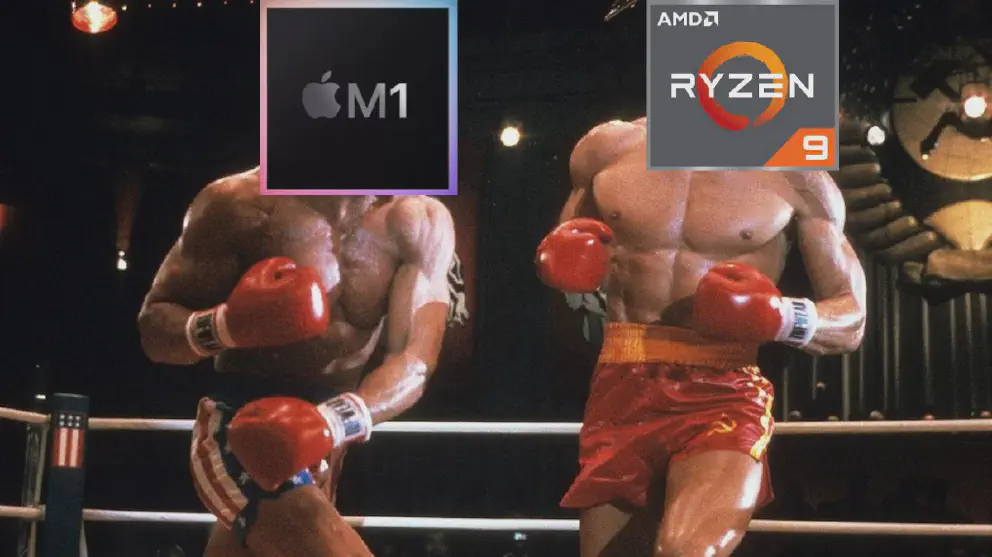Update: We also make a comparison between Intel’s latest Alder Lake CPU against the M1-series, from base to M1 Max. Read about it here
Imagine having the most powerful microprocessor in your hand. It has multilude of cores on a single die and each core can run two threads at the same. In some version of the same processor, it also has an integrated graphics so you can also run 3D software or even gaming on it. This is the AMD Ryzen 9 5900X processor, which is AMD’s flagship processor that is meant for gaming and high performance consumer computing.
Now imaging your competitor release not only a similiar processor, but an entire computer complete with aluminum machined chassis, ports for I/O connections and graphics, power supply (and the power plug too) and shipped in a very well designed packaging and box. That is the still-revolutionary Apple Mac Mini with the M1 chip.
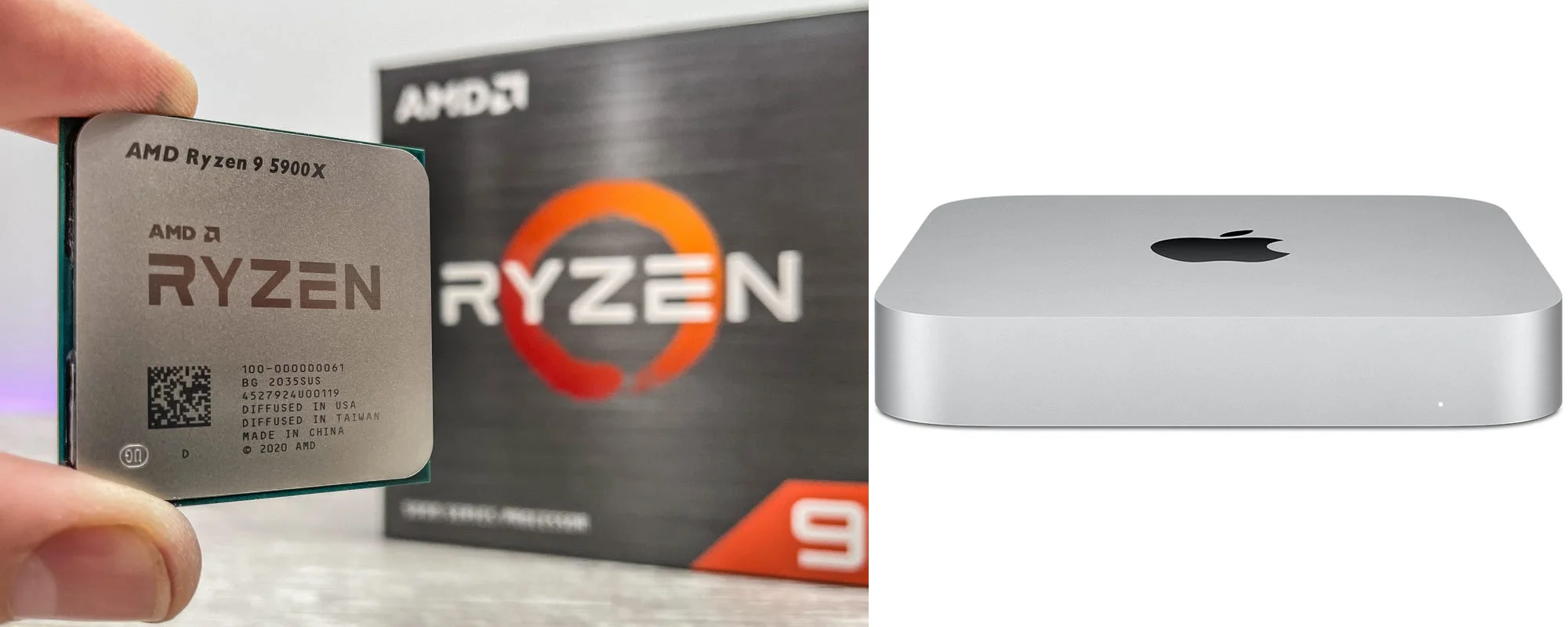
You might be thinking that a $589 chip will beat the crap out of a $599 ($570 on discount) system that is meant for low end computing. You’ll be suprised how close the Apple M1 is at doing it job that it sends competitors back to the drawing board. Read on to find out more.
Apple M1
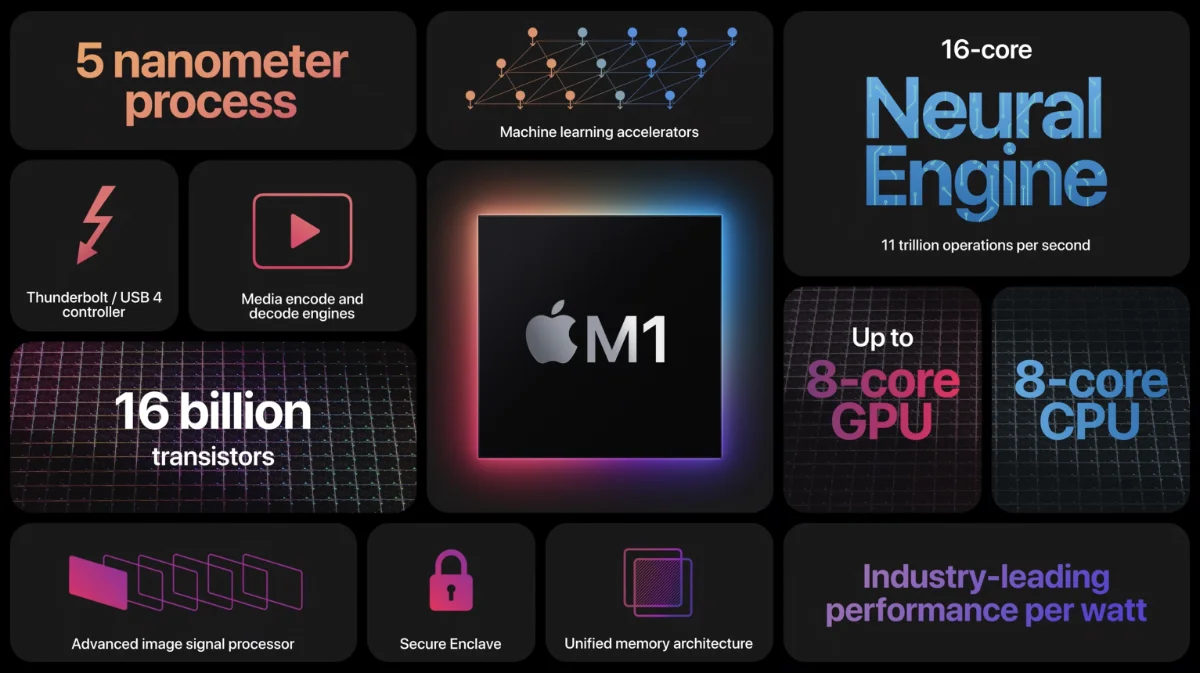
To anyone who is not familiar with the M1 story, here’s what happen so far as of June 2021: In WWDC 2020, Apple announced that they are transition their Macs away from Intel to their own solution called Apple Silicon. They claimed that the transition period would be around 2 years and they will continue to support Intel Macs as long as possible. Fast forword to November 2020, the first products with Apple Silicon is shown: It was the Mac Mini, MacBook Air and the lower end version of the MacBook Pro 13". All use the same chip called the M1, which is basically a scaled up version of the A14 processor that is being used for the iPhone 12 line up.
A few months later in April, a new iMac 24" which replaces the iMac 21.5" was introduced, also using the M1 chip. The iPad Pro has been updated to the new M1 chip, which makes the iPad Pro the most powerful tablet ever created. At this point, pretty much all the lower end offerings has been updated to the new Apple Silicon and people are waiting for the higher end “Pro” models.
The Apple M1 is a continuation of Apple’s effort of building in-house microprocessor since the introduction of the A4 in the first iPad. The A-series has gone many iteration that improve their performance while lowering power consumption and added custom cores such as graphcis, neural network, secure enclave and I/O controller that gives Apple unique capabilities. The result is that M1, which is essentially a scaled up version of the A14 chips that is design for the unique requirements of a laptop / desktop computer.
The M1 is designed by Apple but manufactured by TSMC. Apple designed the M1 based on the ARM instruction set artchitecture. Apple paid the artchitectural license to ARM which gives Apple the right to build their own custom chip which is compatible with ARM ISA.
The M1 chips has 8 cores, 4 high-performance cores with 4 high-efficiency core. It also has 12 graphic cores, a AI core which basically make solving neural network problems faster, a custom I/O controller called Apple Fabric, secure enclave to store confidential information. The RAM sits right next to the processor which lowers latency but does not allow for casual upgrading.
The result is that entire system-on-chip only consume around 15 watts, and can be lowered for fanless solution which is the case for the iPad Pro M1 and the MacBook Air. In fanless solution, the chip can be thermal throttle to preverse the health. What is different from this M1 versus chips like AMD Ryzen or Intel Core, is the the M1 is design around Apple ecosystem in mind. The chip allows Apple to provide unique services like FaceID, TouchID, Potrait mode in FaceTime and Live Text.
AMD Ryzen
The AMD Ryzen takes a more “traditional” approach to chip making. Instead of all-in-one system like the M1, the Ryzen is more dedicated general purpose chip that is designed for customizability and gaming.
Just like Apple, AMD acquire the x86 ISA license from Intel. Later when microprocessor transition from 32-bit memory addressing to 64-bit memory addressing, AMD made their own extension called the x86-64 in which Intel license back from AMD. How this happen is a long stroy and out of scope of this article, but the main point that AMD uses an instruction set from another company. Just like Apple, AMD also does not have their own fab and hire TSMC to make their Ryzen chips.
Ryzen is brand name of a new artitecture from AMD called Zen artchitecture in which the Ryzen 9 5900X is the third revision of the artchitecture. The Ryzen 9 5900 is the pinnacle of AMD line up and have few variants in it. The Ryzen 9 5900X which we will be focus on is the gaming variant of the 5900 series. It has 12 high-performance cores, and each core can process two threads at once, bringing the total amount of threads it can process to 24. It has a massive 70 MB cache on the processor. The base speed of the processor is 3.7 GHz but can be boosted to 4.8 GHz. With the right motherboard, RAM, power supply and cooling, you can overclock the chip even further.

The Ryzen 9 5900X is meant to be a gaming chip, so it does not have any graphic cores in the processor die since it is expected to use external graphics for that. It also does not have any neural engine processor in it since it only focus on floating point number crunching which is the case for high-end games.
During the launch in November 2020, it beat out handily beat out Intel Core i9-10900KF by a wide margin. This Ryzen 9 5900X is considered the best CPU ever made for gaming at launch. Of course, early supply issues not withstanding.
Benchmark Results
One would think that a $600 chip engineered for number crunching would beat out a chip that is engineered to be a low-cost solution for entry level system. One is not mistaken in that believe, but you need to see how close the M1 is in terms of performance on against the AMD Ryzen 9 5900X. More suprising, there are a few benchmarks that the M1 does even better than the Ryzen 9.
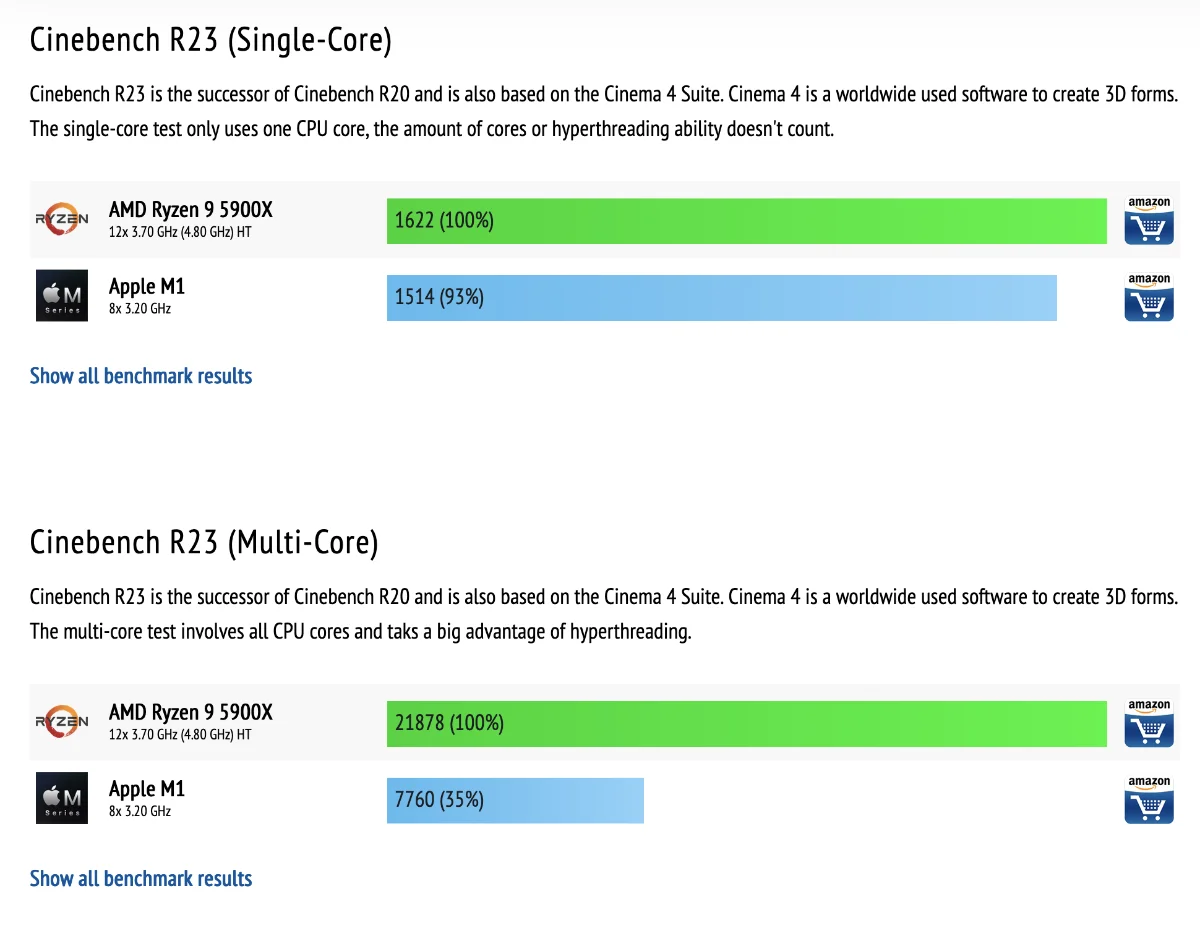

In single core performance, the M1 trails narrowly and sometimes beat the AMD chip. Consider it is impressive when you can get an entire Mac system for the price of a single AMD processor. The multi-core results is where the AMD shine. Having 12 full performance cores instead of 4 high-performance and 4 high-efficiency cores, the AMD Ryzen 9 5900X absolutely bested the M1 by a wide margin. However, there’s a caveat that you need the proper software to take advantage of having that many cores. In benchmarks tests like GeekBench and CineBench, utilizing multiple cores works in AMD favour. If the app does not take advantage of multi core, than the advantages cut down.
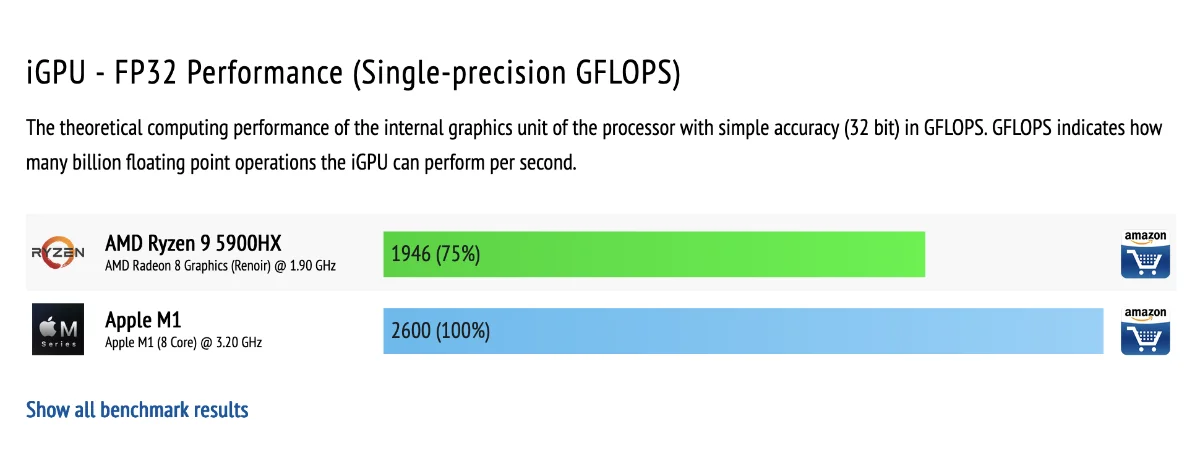
The Ryzen 9 5900X does not have an intergrated graphics since it was designed as a part of a high-end desktop system where it is expected to have a dedicated discreet graphics card. However, there is the Ryzen 9 5900HX, which is a variant of the 5900-series which was designed for gaming laptops. This sacrafice a number of compute cores by putting a Redeon 8 integrated graphics into the Ryzen core. Despite that, the M1 internal graphics is far superior by having a 25% margin in iGPU benchmark.
Conclusion
It is no suprise that AMD flagship, the Ryzen 9 5900X will beat Apple M1 in multi-core workloads, but it is suprising how close the M1 gets to single core workloads. If rumours to be believed, the higher end “Pro” Macs, dubbed the M1X, will have a scaled up version of the M1 chip. This will include more performance cores and double or even quardrable amount of graphic cores. It will be interesting what will happen when Apple bring out bigger guns.
The arrival of the M1 has change the game for the microprocessor industry as Intel and AMD has to review their strategy. Intel now aims to be more like TSMC, taking 3rd party orders. Qualcomm, Apple closest competitor in the mobile chip market is making a desktop version of their mobile chips, just like how Apple does with their M1 from their A14.
Related
We compared the M1 vs AMD’s close cousing, the Intel Core i9 11th generation:-

Apple M1 vs Intel i9-12900K: Comparison between M1 Family (base to Ultra) against Intel's best
The M1 Ultra has landed in March 2022 and is Apple's latest attempt to take back the performance crown from Intel and Nvidia. We take stock of how Apple Silicon performs against Intel’s lineup.
Plug
Support this free website by visiting my Amazon affiliate links. Any purchase you make will give me a cut without any extra cost to you
- Mac Mini M1 - Amazon USA / Amazon UK
- iMac 24" M1 - Amazon USA / Amazon UK
- Mac Studio - Amazon USA
- MacBook Air M1 - Amazon USA / Amazon UK
- MacBook Pro 13" M1 - Amazon USA / Amazon UK
- MacBook Pro 14" M1 Pro / M1 Max - Amazon USA / Amazon UK
- MacBook Pro 16" M1 Pro / M1 Max - Amazon USA / Amazon UK
- Accessories:-
- Wireless earphones / headphones:-
- AirPods - Amazon USA / Amazon UK
- AirPods Pro - Amazon USA / Amazon UK
- AirPods Max - Amazon USA / Amazon UK
- Buyer's Guide:-
